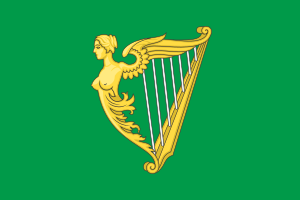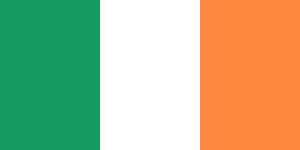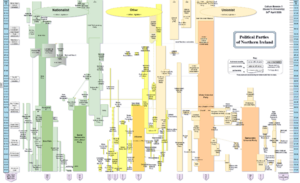Irish nationalism facts for kids

Irish nationalism is a political idea. It means that the people of Ireland should rule their own country as an independent nation. Since the mid-1800s, Irish nationalism has often focused on Irish culture. This includes the Irish language, literature, music, and sports.
Irish nationalism grew stronger when all of Ireland was part of the United Kingdom. This led to most of the island becoming independent in 1922.
Irish nationalists believe that foreign rule by England, starting in 1169, was bad for Ireland. When Ireland was divided in 1922, most of the island was Roman Catholic and had native Irish people. But a large part of the north was Protestant. These people were mostly descendants of settlers from Great Britain. The country was divided along these lines. Most of Ireland became independent. Six northern counties stayed part of the United Kingdom. Today, Irish nationalists want to reunite Ireland as one country.
History of Irish Nationalism
Early Ideas of a Nation
Irish nationalism began to form in the 1500s. At this time, native Irish people and the "Old English" (descendants of earlier English settlers) joined together. They were mostly Catholic. They wanted to protect their land and way of life from new English Protestant forces.
The Plantations of Ireland meant that many Catholic landowners lost their land. It was given to Protestant settlers from England and Scotland. The Plantation of Ulster, starting in 1609, brought many English and Scottish Protestants to the north of Ireland.
Irish leaders fought against the English presence. For example, Hugh O'Neill led the Nine Years' War (1594–1603). He wanted to remove the English from Ireland.

In the 1640s, a group of Irish Catholics formed an independent Irish state. They were called the Confederation of Kilkenny. They wanted Ireland to be a kingdom separate from England, but still under the same king. They also wanted more rights for Catholics. However, Oliver Cromwell's army defeated them (1649–53). This led to Catholic landowners losing even more land.
Later, in the 1680s and 1690s, Irish Catholics supported King James II. He was removed from power in England. These supporters, called Jacobites, also wanted more rights for Catholics and their land back. But they were also defeated in the Williamite War in Ireland (1689–1691). After this, English Protestants largely controlled the government and land in Ireland. Laws called the Penal Laws treated non-Anglicans unfairly.
These events made Irish nationalism strongly linked to being Catholic and Gaelic. It also created a feeling of loss and defeat by British and Protestant forces.
The Rise of Modern Nationalism
Before the Union with Britain
In the 1700s, the Irish Parliament, which was only Protestant, wanted more freedom from the British Parliament. Henry Grattan led a movement that gained Ireland more legislative independence in 1782–83. Grattan also wanted Catholics to have equal political rights.
Modern Irish nationalism, with ideas of democracy, began in the 1790s. This was with the Society of United Irishmen. This group wanted to end unfair treatment of Catholics and Presbyterians. They also wanted to create an independent Irish republic. Many United Irish leaders were inspired by the French Revolution. They wanted a society without religious divisions.
The United Irishmen led the Irish Rebellion of 1798. It was put down with much violence. Because of this, the Irish Parliament voted to join with Britain in the Act of Union of 1800–01. After this, Irish Members of Parliament (MPs) went to London.
After the Union
After these events, two types of Irish nationalism appeared. One was a radical movement called Irish republicanism. It believed that force was needed to create a free Irish republic. Groups like the Young Irelanders, who rebelled in 1848, followed this idea.
The other type of nationalism was more moderate. It pushed for changes from the British government using peaceful methods. The Catholic Church usually supported this peaceful approach.
Daniel O'Connell led the moderate movement. In the 1820s, 1830s, and 1840s, he campaigned for Catholic Emancipation. This meant full political rights for Catholics. He then campaigned for the "Repeal of the Union," which meant Irish self-government under the British Crown. Catholics gained full rights, but self-government did not happen. O'Connell's movement was very Catholic. It had the support of Catholic priests.
The Great Famine and Republican Groups
The Great Famine of 1845–49 caused much anger towards the British government. Many Irish people felt the government did not do enough to stop the deaths of up to a million people.
In 1858, the Irish Republican Brotherhood (IRB) and the Fenian Brotherhood were formed. These were groups of militant republicans in Ireland and the United States. The IRB tried an armed revolt in 1867, but it failed.
In the late 1800s, Irish nationalism became very strong in Ireland. A major Irish political party in the British Parliament at Westminster pushed hard for self-government.
The Land League and Home Rule
Mass support for nationalism grew when the Home Rule League started to focus on social issues in the late 1870s. The most important issue was land ownership. Michael Davitt formed the Irish Land League in 1879. This group fought for the rights of tenant farmers. Many Irish Catholics felt their land had been unfairly taken by Protestant English settlers in the 1600s.
The Land League campaigned for "fair rent, free sale, and fixity of tenure." This meant fair prices for renting land, the right to sell improvements on the land, and secure tenancy. When prices for farm products dropped, farmers refused to pay rent. This became known as the "Land War." It often turned violent when farmers resisted being evicted.
This movement led the British government to help tenants buy land from their landlords. Charles Stewart Parnell, a Protestant landowner, took over the Land League. He used its popularity to form the Irish Parliamentary Party. This party campaigned for Home Rule. Home Rule meant a devolved Irish parliament within the United Kingdom.
Cultural Nationalism and Irish Identity
From the late 1800s, Irish nationalism also focused on Gaelic Irish culture. This was called the Celtic Revival. It was a movement that celebrated Irish language, literature, and arts.
Organizations like the Gaelic League promoted the Irish language. The Gaelic Athletic Association (GAA) was formed to promote Gaelic football, hurling, and Gaelic handball. It even stopped its members from playing English sports.
These groups helped many radical Irish nationalists in the early 1900s. This included leaders of the Easter Rising of 1916, like Patrick Pearse. The main goal was to show how Ireland was different from England.
The Home Rule Crisis (1912–1914)
John Redmond and the Irish Parliamentary Party finally won Home Rule. It was granted under the Third Home Rule Act 1914. However, Irish self-government faced the possibility of Ireland being divided.
In 1912, people in Ulster who supported staying with Britain (called Unionists) strongly opposed Home Rule. They formed the Ulster Volunteers, an armed group, to resist Home Rule by force. British politicians also supported them.
In response, Irish nationalists formed their own armed group, the Irish Volunteers. They wanted to make sure Home Rule was put into action. For several months in 1914, it looked like a civil war might start between these two armed groups.
The Home Rule Act was passed, but it was put on hold when World War I started in August 1914. This made radical republicans believe that Irish independence could never be won peacefully.
World War I and the Easter Rising
The Irish Volunteer movement split over World War I. Most followed John Redmond. They supported the British war effort, hoping it would lead to Home Rule after the war. About 180,000 Irishmen served in the British Army.
A smaller group of Irish Volunteers, led by the Irish Republican Brotherhood (IRB), refused to support the war. They planned a rebellion against British rule in Ireland during the war. James Connolly, a labor leader, joined forces with the IRB.
In April 1916, about a thousand Volunteers and 250 members of the Irish Citizen Army launched the Easter Rising in Dublin. They declared the independence of the Irish Republic. The Rising was put down within a week. About 500 people were killed, mostly civilians.
Even though the Rising failed, the British response made many people angry. General Maxwell executed fifteen of the Rising's leaders. About 3,000 political activists were arrested. This led to widespread public sympathy for the rebels. After this, armed republicanism grew much stronger. For the next seven years, it became the main force in Ireland. It gained significant independence for Ireland, but at the cost of dividing Ireland.
The Irish Parliamentary Party lost support after Home Rule was suspended. They were also hurt by the harsh British response to the Easter Rising. The party was replaced by Sinn Féin. This was a small party that the British had wrongly blamed for the Rising. Sinn Féin then became the main group for Irish Republicanism.
Militant Separatism and Irish Independence
In the general election of 1918, Sinn Féin won 73 seats in Ireland. This was nearly 70% of the Irish representation. However, they had fewer seats in Ulster.
The Sinn Féin MPs refused to take their seats in the British Parliament. Instead, 27 of them set up their own Parliament called the Dáil Éireann in January 1919. They declared the Irish Republic to be independent.
In 1919, a guerrilla war broke out. It was between the Irish Republican Army (IRA) and the British security forces. The IRA was the new name for the Irish Volunteers.
The fighting grew more intense from the summer of 1920. New paramilitary police forces, the Black and Tans and Auxiliary Division, were sent to Ireland. From November 1920 to July 1921, over 1000 people died in the conflict.
Irish Nationalism Today
Northern Ireland is not part of the Republic of Ireland. However, it has a nationalist minority who want to be part of a united Ireland. In Northern Ireland, "nationalist" often refers to the Catholic population. It can also mean supporters of the moderate Social Democratic and Labour Party. This type of nationalism seeks a united Ireland through peaceful ways. The more militant side, supported by Sinn Féin, is usually called "republican." However, the modern Sinn Féin party says it is committed to peaceful and democratic methods.
In the 2016 UK referendum on leaving the European Union, 55.8% of voters in Northern Ireland voted to stay. This was influenced by worries about a hard border between Northern Ireland and the Republic of Ireland. People also feared it would harm the Good Friday Agreement.
Recent political changes have been significant:
- In the 2019 UK general election, more nationalist MPs were elected in Northern Ireland than unionist ones for the first time.
- Two months later, Sinn Féin won the most votes in the 2020 Irish general election. This ended 100 years of dominance by Fine Gael and Fianna Fáil in the Republic.
- At the 2022 Northern Ireland Assembly election, Sinn Féin won the most seats. This was the first time a nationalist party had done so in Northern Ireland's history. This means the Assembly will have its first nationalist First Minister.
Contents
|
|





